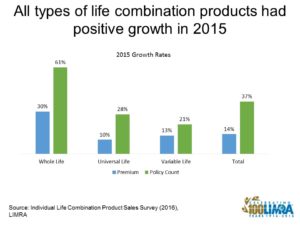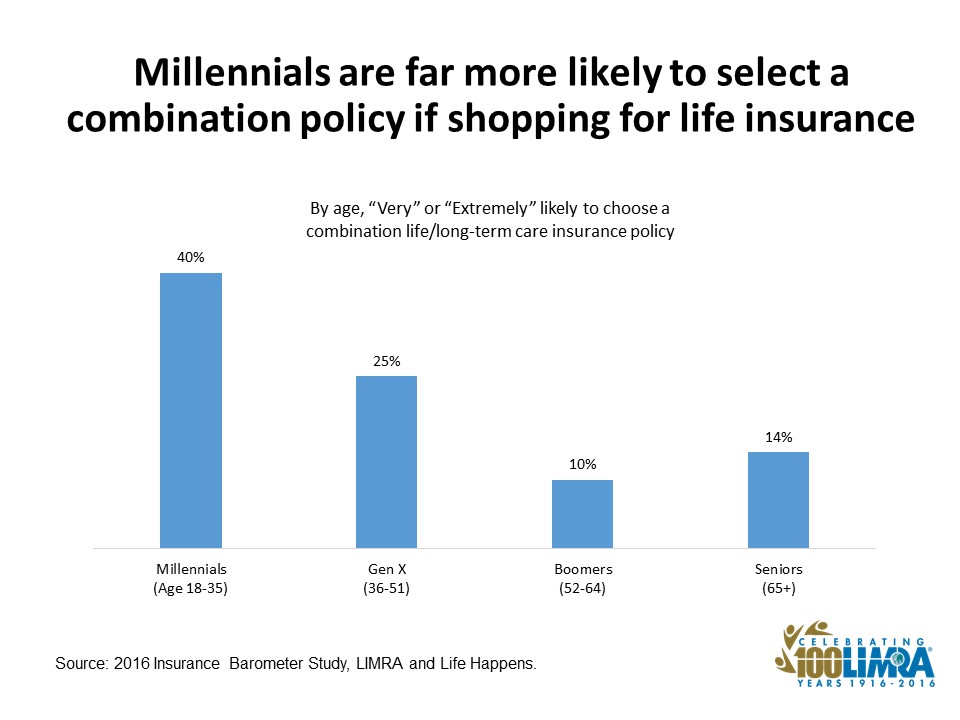

New data in released in late April shows consumer interest in life/long-term care insurance combination products is clearly on the rise, with Millennials showing the most interest.
Individual life combination product new premium increased 14% in 2015, a big rebound from the decline in new premium growth in 2014, according to LIMRA’s 2014 Individual Life Combination Products Annual Review.
New premium totaled $3.1 billion in 2015, which represents 15% of all new premium collected for individual life insurance products. There were more than 200,000 individual life combo policies sold in 2015, a 37% increase compared with 2014 totals.
“Last year’s decline in new premium was mainly due to a shift from single-premium products to limited-pay products. While this shift continued in 2015, single-premium products also exhibited strong growth in 2015, said Karen Terry, LIMRA assistant managing director, Insurance Research. “The growth was widespread, with a dozen companies reporting healthy growth in both premium and policy count.”
Limited-payment life insurance refers to a life insurance policy with a limited number of higher payments by eliminating the life-long payments of the past. LIMRA noted that some companies are shifting from single premium (where the customer pays the entire amount for the insurance in one lump sum) to a limited pay payment structure (where the customer pays at least two payments but not for the rest of their life) for their combination life products. Generally, LIMRA has found the majority of limited pay combination products have less than 10 annual premium payments.
The study found products with chronic illness acceleration riders grew 38% and represent 59% of the combination life insurance market. Products with long-term care acceleration riders experienced stronger growth in 2015, up 51% from prior year, but only represent 28% of the market.
“We see more companies offering CI acceleration riders with their products with no up-front costs and often automatically attach these riders to specific products,” noted Terry.
Sales of all product types increased in 2015. Whole life combination products experienced the largest growth, increasing 30% in premium and 61% in policy count.
Despite this strong performance, universal life combination products continue to hold three-quarters market share by every measure (premium, policy count and face amount).

LIMRA research has been tracking a transition in the long-term care insurance market, expanding to three distinct insurance products: individual long-term care insurance (ILTCi), the life combination product, and the annuity/LTC product. Collective sales for the three products in 2015 are estimated at almost $4 billion with more than 300,000 new lives covered. Due to the cost structure and the added life insurance protection of the product, life combination products account for the majority of the estimated 2015 new dollars.
Of the three distinct insurance products, life combination products are offered by more insurers and continue to see new entrants. More than 20 life carriers are in this market. Currently less than 20 insurers sell in the individual long-term care insurance (ILTCi) market, and an estimated 5 insurers sell an annuity/LTC product.
Interest in combo products growing, especially among Millennials
In the 2016 Insurance Barometer, nearly 6 in 10 consumers said paying for long-term care services was a financial concern, for 10% it was their top concern. While two-thirds of consumers agree that most people need long-term care insurance, only 16% own any.
Traditional long-term care insurance sales have been declining for nearly 10 years as a majority of consumers say they can’t afford it. Products that combine life insurance and long-term care insurance into one policy continues to emerge as an alternative to address consumers’ needs.
LIMRA has tracked sales of combination products since 2007 and has found steady growth in new premium and new policies. As previously mentioned, new premium for combo products increased 15% in 2015 and new policy counts more than doubled, going from 100,000 to 220,000.
In terms of consumer awareness, the Barometer study found that 60% of consumers said they understand the product with the highest awareness among Millennials at 65%.
The study revealed that 24% would be very or extremely likely to choose a combination product if they were purchasing life insurance. Another 34% said they would be somewhat likely to choose one, suggesting that nearly 60% of consumers would consider a combination policy.
Looking closer at the strongest likelihood of purchase, Millennials lead the way at 40%, with Gen X a distant second at 25%. This finding is consistent with Millennial responses to concerns about financial issues. Paying for long-term care services rated slightly higher than average as a concern for Millennials (62%) while paying for medical expenses and supporting themselves if they become disabled were equally concerning for 70% of Millennials.
What’s the appeal of combination products? For 36% of consumers, it’s the idea that a life benefit will be paid even if long-term care expenses are never needed. Similarly, 36% of all consumers and 41% of Millennials said a combination policy would be a more economical use of their assets.

- Pacific Life takeover of former Genworth Lynchburg life operation helps stabilize the term market - September 7, 2017
- Insurtech Updates: Launches, expansions, partnerships and more - June 6, 2017
- Industry trade media brands disappearing: A closer look - March 29, 2017
